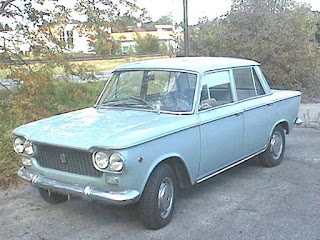Fiat 1300 - Milletrecento - Zastava 1300 - Tristać
The Corvair range included two-door coupe and convertible, four-door sedan, and four-door station wagon configurations, included the more powerful Monza model – and included passenger van, commercial van, and pickup derivatives. The range competed with imported cars such as the original Volkswagen Beetle, as well as the Ford Falcon and the Plymouth Valiant, new entries in a market segment that was established in the U.S. by the Nash and Rambler American.
The Corvair's legacy was affected by controversy surrounding its handling, which led to its inclusion in Ralph Nader's Unsafe at Any Speed. Nonetheless a subsequent National Highway Traffic Safety Administration (NHTSA) study concluded that the car's handling was as safe as that of its contemporaries.
Origin 1960 Corvair Assembly line – engine and suspension sub-assemblies lifted to a 700 series sedan body The Corvair name originated for a 1954 Corvette fastback show car. The car's development was directed by Ed Cole, holding chief engineer and general manager positions at Chevrolet during the 1950s. It was General Motors' response to the growing popularity of small, lightweight imported cars such as the original Volkswagen Beetle, as well as to compete with domestic-built compact cars, the Rambler American and Studebaker Lark. The "compact" term was coined by George W. Romney as a euphemism for small cars with a wheelbase of 110 inches (2,794 mm) or less.
The Corvair's design began in 1956 with the first vehicles rolling off the assembly line in late 1959 for the 1960 model year. The car was introduced October 2, 1959 initially as a four-door sedan offered in two trim levels. Two Corvairs were tested at the Riverside International Raceway in California, for 24 hours. One car rolled over, but the other completed the drive consuming only one quart (0.95 L) of oil.
The Chevrolet Corvair engine was a flat-6 (or boxer engine) piston engine used exclusively in the 1960s Chevrolet Corvair automobile. It was a highly unusual engine for General Motors: It was air-cooled, used a flat design, with aluminum heads (incorporating integral intake manifolds) and crankcase, with individual iron cylinder barrels. The heads were modeled after the standard Chevrolet overhead valve design, with large valves operated by rocker arms, actuated by pushrods run off a 9 lobe camshaft (due to the unique engine layout, exhaust lobes operated valves on *both* sides of the engine), running directly in the crankcase bore without an inserted bearing, operating hydraulic valve lifters, as used on most Chevrolet OHV engines.
The flat horizontally opposed ("flat engine") air-cooled engine design, previously used by Volkswagen and Porsche as well as Lycoming aircraft engines, offered many advantages. Unlike inline or V designs, the horizontally opposed design made the engine inherently reasonably well balanced, so that counterweights on the crankshaft were generally not necessary, reducing the weight greatly. Eliminating a water-cooling system further reduced the weight, and the use of aluminum for the heads and crankcase capitalized on this weight reduction; so that with the use of aluminum for the transaxle case, the entire engine/transaxle assembly weighed under 500 pounds (225 kilograms).
In addition, the elimination of water-cooling eliminated several points of maintenance and possible failure, reducing them all to a single point; the fan belt. As with the Volkswagen and Porsche designs, the low weight and compact but wide packaging made the engine ideal for mounting in the rear of the car, eliminating the weight and space of a conventional driveshaft.
Two years after its 1960 debut, the Corvair engine gained another unusual attribute: it was the second production engine ever to be equipped from the factory with a turbocharger, released shortly after the Oldsmobile Jetfire V8. Aircraft hobbyists and small volume builders, perhaps seeing the Corvair engine's similarity to Lycoming aircraft engines, very quickly began a cottage industry of modifying Corvair engines for aircraft use, which continues to this day.
The Corvair engine also became a favorite for installation into modified Volkswagens and Porsches, as well as dune buggies and homemade sports and race cars.
The 50 Worst Cars of All Time
Rear-engine cars are fun to drive and even more fun to crash. While rear-engine packaging offers enormous advantages, putting the vehicle's heaviest component behind the rear axle gives cars a distinct tendency to spin out, sort of like an arrow weighted at the end. During World War II, Nazi officers in occupied Czechoslovakia were banned from driving the speedy rear-engined Tatras because so many had been killed behind the wheel. Chevrolet execs knew the Corvair — a lithe and lovely car with an air-cooled, flat-six in the back, a la the VW Beetle — was a handful, but they declined to spend the few dollars per car to make the swing-axle rear suspension more manageable.
Ohhh, they came to regret that. Ralph Nader put the smackdown on GM in his book Unsafe at Any Speed, also noting that the Corvair's single-piece steering column could impale the driver in a front collision. Ouch! Meanwhile, the Corvair had other problems. It leaked oil like a derelict tanker. Its heating system tended to pump noxious fumes into the cabin. It was offered for a while with a gasoline-burner heater located in the front "trunk," a common but dangerously dumb accessory at the time. Even so, my family had a Corvair, white with red interior, and we loved it... - time.com -
Chevrolet Corvair vs Zastava 1300 / 1500 - Fiat milletrecento






 Z
Z









No comments:
Post a Comment